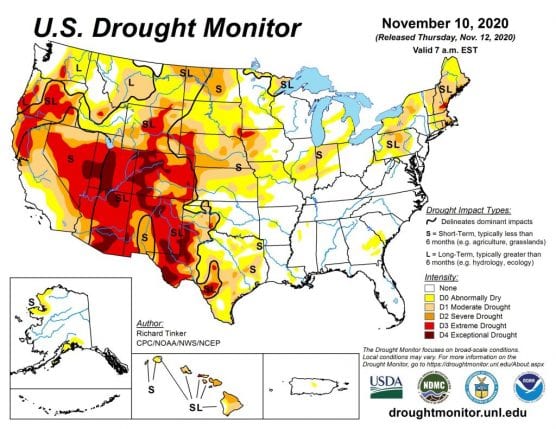A report by the U.S. Drought Monitor on Thursday confirmed what anyone living in California or the Southwest already know: We need rain. Badly.
“Abnormal dryness and drought are currently affecting over 120 million people across the United States including Puerto Rico — about 38.9% of the population,” the National Centers for Environmental Information, of which the U.S. Drought Monitor is a part, said in its latest report.
The drought is particularly intense in the Four Corners region where Colorado, Arizona, New Mexico and Utah intersect. And things have gotten worse in Nevada, where ranchers say the range is in poor condition.
“It’s as bad as I’ve ever seen it,” said JJ Goicoechea, a rancher who lives near Elko in eastern Nevada. “I’ve bought more hay this year than I have the previous two.”
The situation is also dire in Colorado, where 75% of the state is experiencing severe drought and a quarter is firmly in the worst category — extreme drought. Much of the worst aspects of dry conditions are centered on the Colorado River Basin of western Colorado, which bodes ill for the millions of homes and businesses downstream that rely on a robust flow of water from the river.
Reservoirs like Lake Powell and Lake Mead have dipped to below-average levels, with Lake Powell receiving just 43% of its average inflow with only a month and a half to go in the year, according to the Lake Powell Water Database.
A storm in the Pacific Northwest brought relief to the northern areas of Oregon, much of Washinton and the northwest corner of Montana, but failed to deliver water to much of Oregon and a slice of Northern California that remain parched.
“Amounts were insufficient to bring improvement anywhere to south and east of northern Oregon, and conditions deteriorated in Northern California, and in much of a broad swath from southwestern California eastward across New Mexico,” the agency wrote in the Drought Monitor report.
Extreme drought is growing in Northern California, but only in the northern reaches of the state along the Sacramento River.
However, forecasts call for relief as an unseasonal precipitation event may dip down into Northern California after dropping significant amounts of rain across much of the Pacific Northwest.
The Rockies is also on tap for some wet weather in the coming days, stoking optimism that the worst of their drought is in the rearview.
Colorado has experienced three of the largest wildfires in state history this year, with the latest burning more than 200,000 acres including parts of Rocky Mountain National Park. Drought certainly played a role.
California too grappled with a historic wildfire season, with more than 4 million acres torched by a series of fires across the length of the state — a record. Oregon and Washington state saw numerous large blazes as well.
In Texas, drought is on the march in Texas where a fifth of the state is in extreme drought — nearly double from just last week. The dry conditions are concentrated in the Llano Estacado or the Stalked Plains in the western part of the state. Cities like Odessa and Lubbock are in the middle of the drought-plagued region.
“Conditions are abnormally dry or worse across much of the state,” the Drought Monitor report states.
Even the Northeast is experiencing abnormally dry conditions as autumn progresses, with southern Maine and northern New Hampshire in extreme drought.
No new rain is expected to fall in the region, though a wet winter is predicted.
The outlook isn’t as rosy for California and the rest of the American West, which need several storms during their respective wet seasons to rescue the land from dry conditions.
— By Matthew Renda
Like this:
Like Loading...
Related





 Tweet This
Tweet This Facebook
Facebook Digg This
Digg This Bookmark
Bookmark Stumble
Stumble RSS
RSS


























REAL NAMES ONLY: All posters must use their real individual or business name. This applies equally to Twitter account holders who use a nickname.
0 Comments
You can be the first one to leave a comment.